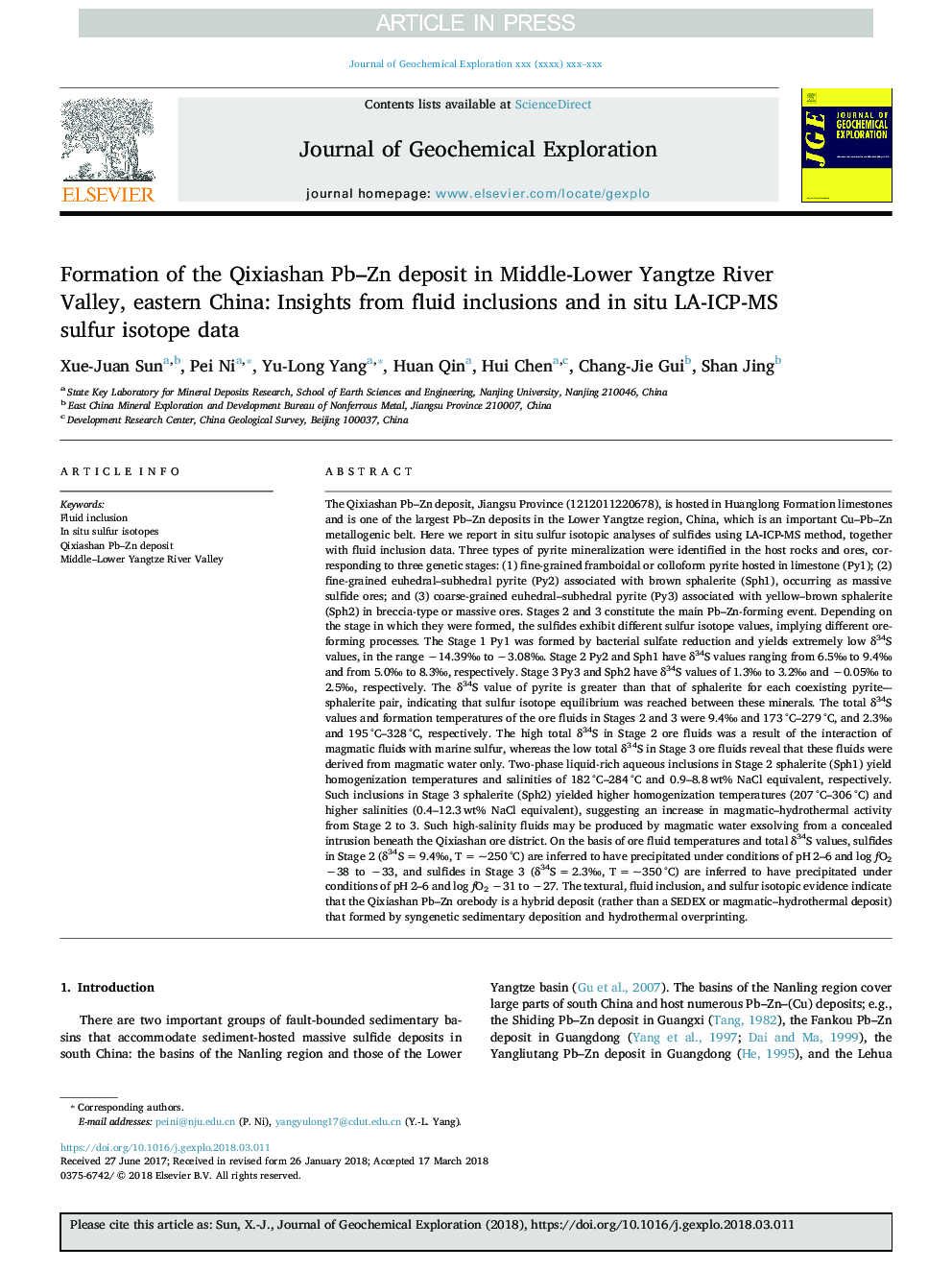| کد مقاله | کد نشریه | سال انتشار | مقاله انگلیسی | نسخه تمام متن |
|---|---|---|---|---|
| 8865851 | 1620865 | 2018 | 15 صفحه PDF | دانلود رایگان |
عنوان انگلیسی مقاله ISI
Formation of the Qixiashan Pb-Zn deposit in Middle-Lower Yangtze River Valley, eastern China: Insights from fluid inclusions and in situ LA-ICP-MS sulfur isotope data
دانلود مقاله + سفارش ترجمه
دانلود مقاله ISI انگلیسی
رایگان برای ایرانیان
کلمات کلیدی
موضوعات مرتبط
مهندسی و علوم پایه
علوم زمین و سیارات
زمین شناسی اقتصادی
پیش نمایش صفحه اول مقاله

چکیده انگلیسی
The Qixiashan Pb-Zn deposit, Jiangsu Province (1212011220678), is hosted in Huanglong Formation limestones and is one of the largest Pb-Zn deposits in the Lower Yangtze region, China, which is an important Cu-Pb-Zn metallogenic belt. Here we report in situ sulfur isotopic analyses of sulfides using LA-ICP-MS method, together with fluid inclusion data. Three types of pyrite mineralization were identified in the host rocks and ores, corresponding to three genetic stages: (1) fine-grained framboidal or colloform pyrite hosted in limestone (Py1); (2) fine-grained euhedral-subhedral pyrite (Py2) associated with brown sphalerite (Sph1), occurring as massive sulfide ores; and (3) coarse-grained euhedral-subhedral pyrite (Py3) associated with yellow-brown sphalerite (Sph2) in breccia-type or massive ores. Stages 2 and 3 constitute the main Pb-Zn-forming event. Depending on the stage in which they were formed, the sulfides exhibit different sulfur isotope values, implying different ore-forming processes. The Stage 1 Py1 was formed by bacterial sulfate reduction and yields extremely low δ34S values, in the range â14.39â° to â3.08â°. Stage 2 Py2 and Sph1 have δ34S values ranging from 6.5â° to 9.4â° and from 5.0â° to 8.3â°, respectively. Stage 3 Py3 and Sph2 have δ34S values of 1.3â° to 3.2â° and â0.05â° to 2.5â°, respectively. The δ34S value of pyrite is greater than that of sphalerite for each coexisting pyrite-sphalerite pair, indicating that sulfur isotope equilibrium was reached between these minerals. The total δ34S values and formation temperatures of the ore fluids in Stages 2 and 3 were 9.4â° and 173â¯Â°C-279â¯Â°C, and 2.3â° and 195â¯Â°C-328â¯Â°C, respectively. The high total δ34S in Stage 2 ore fluids was a result of the interaction of magmatic fluids with marine sulfur, whereas the low total δ34S in Stage 3 ore fluids reveal that these fluids were derived from magmatic water only. Two-phase liquid-rich aqueous inclusions in Stage 2 sphalerite (Sph1) yield homogenization temperatures and salinities of 182â¯Â°C-284â¯Â°C and 0.9-8.8â¯wt% NaCl equivalent, respectively. Such inclusions in Stage 3 sphalerite (Sph2) yielded higher homogenization temperatures (207â¯Â°C-306â¯Â°C) and higher salinities (0.4-12.3â¯wt% NaCl equivalent), suggesting an increase in magmatic-hydrothermal activity from Stage 2 to 3. Such high-salinity fluids may be produced by magmatic water exsolving from a concealed intrusion beneath the Qixiashan ore district. On the basis of ore fluid temperatures and total δ34S values, sulfides in Stage 2 (δ34Sâ¯=â¯9.4â°, Tâ¯=â¯~250â¯Â°C) are inferred to have precipitated under conditions of pHâ¯2-6 and log fO2 â38 to â33, and sulfides in Stage 3 (δ34Sâ¯=â¯2.3â°, Tâ¯=â¯~350â¯Â°C) are inferred to have precipitated under conditions of pHâ¯2-6 and log fO2 â31 to â27. The textural, fluid inclusion, and sulfur isotopic evidence indicate that the Qixiashan Pb-Zn orebody is a hybrid deposit (rather than a SEDEX or magmatic-hydrothermal deposit) that formed by syngenetic sedimentary deposition and hydrothermal overprinting.
ناشر
Database: Elsevier - ScienceDirect (ساینس دایرکت)
Journal: Journal of Geochemical Exploration - Volume 192, September 2018, Pages 45-59
Journal: Journal of Geochemical Exploration - Volume 192, September 2018, Pages 45-59
نویسندگان
Xue-Juan Sun, Pei Ni, Yu-Long Yang, Huan Qin, Hui Chen, Chang-Jie Gui, Shan Jing,